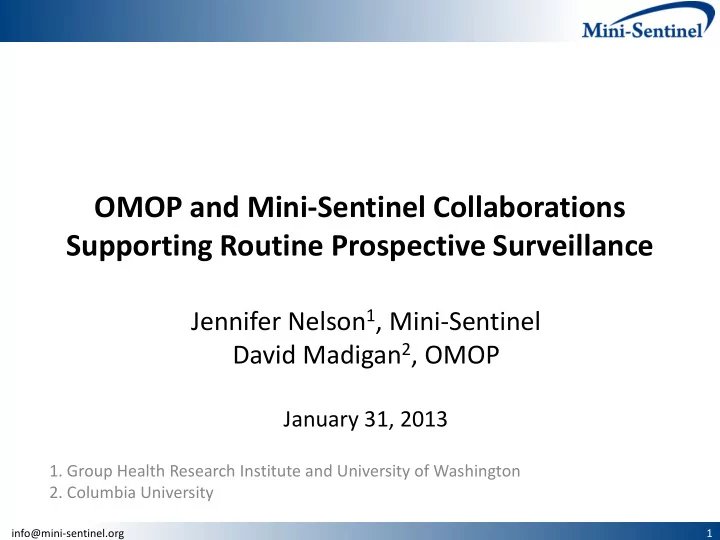

OMOP and Mini-Sentinel Collaborations Supporting Routine Prospective Surveillance Jennifer Nelson 1 , Mini-Sentinel David Madigan 2 , OMOP January 31, 2013 1. Group Health Research Institute and University of Washington 2. Columbia University info@mini-sentinel.org 1
Some history… OMOP began its activities in 2007 − Characterize the effectiveness of different epidemiological and statistical methods for estimating the effects of medical products using large-scale observational data Mini-Sentinel got underway at the end of 2009 − Create an active surveillance system, including routine prospective safety monitoring, for FDA-regulated medical products using electronic health care data Key area of shared interest and research − Developing and evaluating methods for active surveillance − Identify and address barriers and challenges info@mini-sentinel.org 2
Methodological challenges All the usual observational study biases…and more • New purpose • Rapid detection of safety signals as product uptake occurs – Scaled up to monitor many, diverse medical products – New setting (not a research environment) • Unpredictable uptake rate, composition of users over time – Distributed data environment, constrains analytics – New data sources • Data are dynamic, data quality needs constant study – Heterogeneity across sites is large, must be addressed – info@mini-sentinel.org 3
Collaborative methods vision Leaders from both OMOP and Mini-Sentinel involved in crafting the original Mini-Sentinel methods agenda − Methods for generating hypotheses − Methods for refining and testing hypotheses − Methods to evaluate and improve method performance Mini-Sentinel investigators have spent 3 years systematically implementing aspects of this plan One such activity was led by OMOP and helped evaluate and push forward self-controlled methods for use in Mini-Sentinel info@mini-sentinel.org 4
Self-controlled methods workgroup • Open methods questions in safety surveillance setting – When are self-controlled methods advantageous over other designs? – What extensions are desirable (e.g., Bayesian, multi-drug) ? – What is the opportunity for multi-drug outcome-focused active surveillance vs surveillance of a target drug? • Specific working group aims – Describe key differences, strengths, and limitations of self-controlled case series (SCCS) vs case-crossover designs – Overview the usage of case-based designs in published studies – Assess OMOP ’ s multi-drug SCCS and other new SCCS developments – Make recommendations to Mini-Sentinel info@mini-sentinel.org 5
Other Mini-Sentinel methods work groups • How can we systematize and expedite the selection of an appropriate surveillance design? • What data and analysis methods are best-suited for use in Mini-Sentinel ’ s distributed data setting? • How can sequential testing methods be best adapted to achieve rapid detection while minimizing errors? • What methods should be conducted to further evaluate a signal generated by routine surveillance? info@mini-sentinel.org 6
Current status: Mini-Sentinel Mini-Sentinel work has culminated in development of a Routine Prospective Surveillance plan and methods − OMOP leaders have participated in this work Designed to conduct semi-automated, prospective surveillance to complement protocol-based evaluations – Less resource intensive, less control of systematic biases – Ability to generate potential signals for further assessment Created a methods toolbox, diverse and flexible options Some are methods or variants of those assessed by OMOP Includes self-controlled, matching, regression approaches info@mini-sentinel.org 7
Current status: OMOP Completed two large-scale experiments to evaluate competing methods for estimating the effects of medical interventions Developed a process for choosing the optimal customized analytic method for a given context Developed approaches for calibrating p-values and confidence intervals to deliver correct the correct Type I error rate and coverage properties Developed a Bayesian framework for synthesizing empirical evidence info@mini-sentinel.org 8
Current status: Joint Collaborations Since June 2012: Mini-Sentinel developing and testing code for use in Routine Prospective Surveillance − Continued participation by and input from OMOP Sept 2012: Joint OMOP/Mini-Sentinel meeting − Synthesized prior work, generated ideas for future joint work − Ideas leverage experience and expertise of OMOP and Mini- Sentinel and improve Routine Prospective Surveillance plans Oct-Dec 2012: FDA input obtained, ideas refined Early January 2013: OMOP/Mini-Sentinel leaders met again with FDA to select topic to be pursued together − Design and implement a methods performance evaluation info@mini-sentinel.org 9
Performance evaluation plans Review existing evaluation work Current suite of OMOP experimental results Simulation evaluations conducted within Mini-Sentinel Identify key gaps in of the performance of existing Routine Prospective Surveillance methods Develop an evaluation framework and metrics to assess these unanswered performance aspects Identify appropriate setting to conduct the evaluation Design and implement the performance evaluation to address these gaps using the developed metrics info@mini-sentinel.org 10
Next steps Continued participation by OMOP in Mini-Sentinel ’ s existing Routine Prospective Surveillance group New joint working group has been formed to develop the scope of work, timeline, and required resources for the OMOP/Mini-Sentinel method performance evaluation project Specific OMOP/Mini-Sentinel research projects getting underway info@mini-sentinel.org 11
Recommend
More recommend